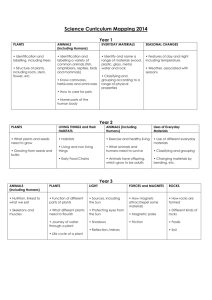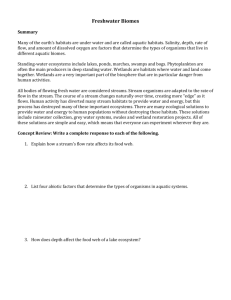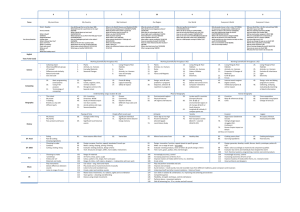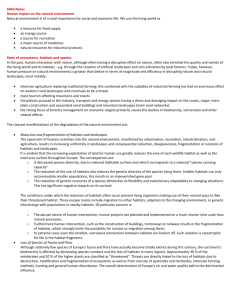Habitats
advertisement
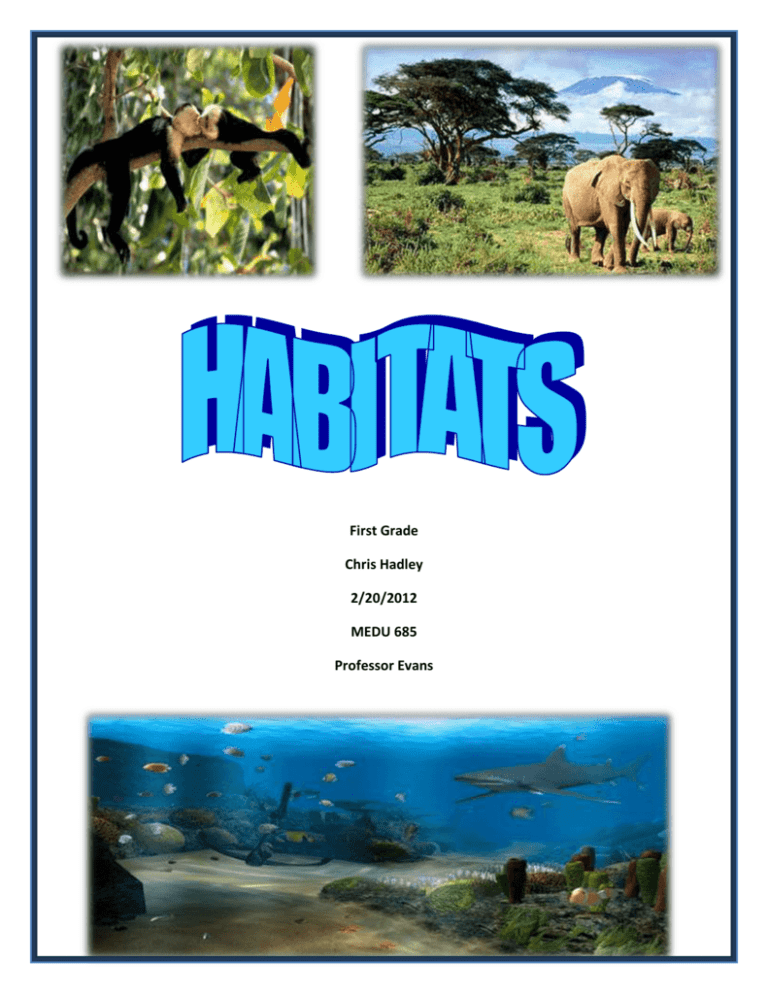
First Grade Chris Hadley 2/20/2012 MEDU 685 Professor Evans Habitats Background Summary A habitat is the natural environment in which an animal, plant, or organism lives. There are many different types of habitats which vary in temperature, moisture, light, size, and many other characteristics. According to Enchanted Learning (2010), a “complex community of plants and animals in a region and climate is also known as a biome. Examples of biomes or habitats include desert, coral reef, tropical rainforest and arctic/tundra. A habitat provides the basic needs for an animal; shelter, air, water, food, and space. Shelter is needed for protection from weather and predators. Oxygen from the air or dissolved in water is required for animals to breath. All living things require food and water for energy to grow and reproduce. The amount of space necessary to find food, water, shelter, and a mate is different for all animals (Woodlands, 2012). A rainforest is a habitat that covers a large area where many trees, plants, and animals live. It is very dense, warm, and wet. It provides a great deal of shade and plenty of rainfall of at least eighty inches per year, but usually much more. Tropical rainforests are found near the equator and the climate is always warm between sixty-eight and seventy-seven degrees Fahrenheit. The major areas of rainforests are in South East Asia, West Africa, and South and Central America. Although rainforests cover a small percentage of the Earth’s surface they contain more than half of the world’s plants and animals. As many as 30 million species of plants and animals live in rainforests. Most animals in the rainforest live in the trees. Examples of animals and plants that live in the rain forest include monkeys, toucans, macaws, tree frogs, chameleons, geckos, butterflies, hanging vines, and flowers (Mongabay, 2012). Deserts cover more than one-fifth of the Earth’s land. They are very dry and can be extremely hot or extremely cold. Temperatures can range from freezing to one-hundred and twenty degrees in deserts across the world. Temperatures from day to night can also vary up to fifty degrees. Deserts receive less than ten inches per year of rainfall. Most hot deserts are found near the Tropic of Cancer and the Tropic of Capricorn and most cold are near the Arctic. Some places deserts can be found are Africa, Arizona, Antarctica, and Mexico. Many animals in the desert are nocturnal. Examples of animals that live in the desert are camels, ostrich, meercat, lizards, black widows, kangaroo, and gazelles. Plants like cacti and brittle bush exist in the desert (National Geographic, 2012). The tundra habitat is near the North Pole. About one-fifth of the Earth’s land is tundra and the average temperature is between ten and twenty degrees Fahrenheit. The ground is permanently frozen from between ten inches to three feet down. The top sections of the soil may thaw during the brief summers enough for low growing plants and microorganisms to grow and reproduce but they will become dormant in the winter. There are very few plants. Animals that one might find in the tundra include polar bears, gray wolves, caribou, snow geese, mountain goats, and sheep (National Geographic, 2012). Coral reefs are found mostly in the tropics in warm water with a temperature between seventy and eighty-five degrees. They usually develop in shallow water near land. The structures are formed from coral polyps. When the polyps die, they leave behind a hard, stony, branching structure made of limestone. Coral reefs can be found in many places of which include the USA, Caribbean, Brazil, India, Africa, Australia, Polynesia, and the Red Sea. Many different animals are sheltered in coral reefs. Some examples include fish, blacktip reef sharks, eels, anemones, jellyfish, crustaceans, turtles, octopus, and sponges (Enchanted Learning, 2010). Focus The purpose of this unit is to teach the students about habitats through each content area while meeting state benchmarks. This unit will cover four habitats: rainforest, desert, tundra, and coral reef. We will learn about climate, location, plants, and animals in each of the four habitats. In science, we will examine what a habitat is, several types of habitats and their environment, and the animals, plants and other organisms living in them. We will compare and contrast them along with our own homes. We will discuss basic needs and how a habitat provides them. In social studies we will discuss locations on the globe where different habitats exist. We will also discuss extinction and the human role. We will be creating animals and other items that exist in each habitat in art in order to create habitats in our classroom. We will use math skills such as sorting and grouping in order to place animals and plants in the correct habitat while playing a game. I will also use animals and plants in basic addition and subtraction. In language arts, we will read several books that discuss habitats. We will also write a descriptive paper about a habitat of our choice as well as keep log books throughout the unit. We will create a dictionary of terms. We will learn a song about habitats incorporating music into our lessons. In the content area of physical education we will play a game called crab, frog, horse as well as take a nature walk observing natural habitats. We will end the unit by taking a fieldtrip to the zoo to observe animals and their habitats. We will discuss our observations. We will use a great deal of cooperative learning, observation, discussion, and engaged learning in the unit. There will also be direct instruction. We will incorporate technology through the use of the smartboard, overhead projector, and computer. Various assessment methods will be used throughout including observation, discussion, worksheets, tests, descriptive papers, and logbooks. Unit Benchmarks Science STATE GOAL 11: Understand the processes of scientific inquiry and technological design to investigate questions, conduct experiments and solve problems. A. Know and apply the concepts, principles and processes of scientific inquiry. 11.A.1a Describe an observed event (LP3, LP4, LP7, LP9) 11.A.1f Compare observations of individual and group results. (LP3, LP4, LP7, LP9) STATE GOAL 12: Understand the fundamental concepts, principles and interconnections of the life, physical and earth/space sciences. A. Know and apply concepts that explain how living things function, adapt and change. 12.A.1b Categorize living organisms using a variety of observable features (e.g., size, color, shape, backbone). (LP3, LP4, LP6, LP7, LP8, LP9, LP10) B. Know and apply concepts that describe how living things interact with each other and with their environment. 12.B.1a Describe and compare characteristics of living things in relationship to their environments. (LP1, LP2, LP3, LP4, LP5, LP6, LP7, LP9, LP10) 12.B.1b Describe how living things depend on one another for survival. (LP4, LP5) Social Science STATE GOAL 17: Understand world geography and the effects of geography on society, with an emphasis on the United States. A. Locate, describe and explain places, regions and features on the Earth. 17.A.1a Identify physical characteristics of places, both local and global (e.g., locations, roads, regions, bodies of water). (LP2, LP4, LP5, LP6, LP7) B. Analyze and explain characteristics and interactions of the Earth’s physical systems. 17.B.1b Describe physical components of ecosystems (LP2, LP3, LP4, LP6, LP7, LP9, LP10) 17.B.2b Explain how physical and living components interact in a variety of ecosystems including desert, prairie, flood plain, forest, tundra (LP4, LP6, LP7, LP8) Math STATE GOAL 9: Use geometric methods to analyze, categorize and draw conclusions about points, lines, planes and space. B. Identify, describe, classify and compare relationships using points, lines, planes and solids. 9.B.1b Sort, classify and compare familiar shapes. (LP7) STATE GOAL 10: Collect, organize and analyze data using statistical methods; predict results; and interpret uncertainty using concepts of probability. A. Organize, describe and make predictions from existing data. 10.A.1a Organize and display data using pictures, tallies, tables, charts or bar graphs. (LP5, LP7, LP8, LP9) B. Formulate questions, design data collection methods, gather and analyze data and communicate findings. 10.B.1b Collect, organize and describe data using pictures, tallies, tables, charts or bar graphs. (LP5, LP7, LP8, LP9) Language Arts STATE GOAL 1: Read with understanding and fluency. A. Apply word analysis and vocabulary skills to comprehend selections. 1.A.1b Comprehend unfamiliar words using context clues and prior knowledge; verify meanings with resource materials. (LP1, LP2, LP3, LP4, LP5, LP6) C. Comprehend a broad range of reading materials. 1.C.1a Use information to form questions and verify predictions (LP2, LP3, LP4, LP5, LP6) 1.C.1c Make comparisons across reading selections. (LP3, LP5, LP6) 1.C.1f Use information presented in simple tables, maps and charts to form an interpretation (LP5) STATE GOAL 3: Write to communicate for a variety of purposes. A. Use correct grammar, spelling, punctuation, capitalization and structure. 3.A.1 Construct complete sentences which demonstrate subject/verb agreement; appropriate capitalization and punctuation; correct spelling of appropriate, high-frequency words; and appropriate use of the eight parts of speech. (LP1, LP3, LP4, LP6, LP7, LP10) B. Compose well-organized and coherent writing for specific purposes and audiences. 3.B.1b Demonstrate focus, organization, elaboration and integration in written compositions (e.g., short stories, letters, essays, reports). (LP3, LP10) STATE GOAL 4: Listen and speak effectively in a variety of situations. A. Listen effectively in formal and informal situations. 4.A.1a Listen attentively by facing the speaker, making eye contact and paraphrasing what is said. (LP1, LP2, LP3, LP8) 4.A.1b Ask questions and respond to questions from the teacher and from group members to improve comprehension. (LP1, LP2, LP3, LP4, LP8) 4.A.1c Follow oral instructions accurately. (LP1, LP2, LP3, LP4, LP8) B. Speak effectively using language appropriate to the situation and audience. 4.B.1a Present brief oral reports, using language and vocabulary appropriate to the message and audience (e.g., show and tell). (LP8) 4.B.1b Participate in discussions around a common topic. (LP1, LP2, LP4, LP8) Art STATE GOAL 26: Through creating and performing, understand how works of art are produced. B. Apply skills and knowledge necessary to create and perform in one or more of the arts. 26.B.1c Music: Sing or play on classroom instruments a variety of music representing diverse cultures and styles. (LP5, LP6) 26.B.1d Visual Arts: Demonstrate knowledge and skills to create visual works of art using manipulation, eye-hand coordination, building and imagination. (LP1, LP3, LP4, LP5, LP6, LP8) PE STATE GOAL 19: Acquire movement skills and understand concepts needed to engage in healthenhancing physical activity. B. Analyze various movement concepts and applications. 19.B.1 Understand spatial awareness and relationships to objects and people (LP6) STATE GOAL 20: Achieve and maintain a health-enhancing level of physical fitness based upon continual self-assessment. A. Know and apply the principles and components of health-related fitness. 20.A.1b Engage in sustained physical activity that causes increased heart rate, muscle strength and range of movement. (LP3) STATE GOAL 21: Develop team-building skills by working with others through physical activity. A. Demonstrate individual responsibility during group physical activities. 21.A.1a Follow directions and class procedures while participating in physical activities (LP6, LP10) Student Profiles Student A: Student A is a first grade female, Barbara Zatowski. Barbara has trouble in the classroom controlling her impulses. She often blurts out answers and does not finish listening to the question. She frequently forgets to raise her hand. She also has trouble following directions completely making careless mistakes and seeing a task to completion. She is easily distracted. She is currently reading below grade level and receiving forty minutes per day of ELL. She also receives an additional thirty minutes a week of reading with a specialist. Her math scores are below grade level. It appears that when assessed orally, she performs better. Barbara’s inability to follow directions and lack of focus are getting in the way of her achievement. It does not mean that she does not necessarily know the material. Her poor performance could be a result of not following direction, not understanding directions, or an inability to express herself in writing. Student B: Student B first grade male Winston Jones. He is very outgoing, loves to talk, and enjoys attention and an audience. This is evident when he is bored and begins talking to his peers during instruction time. Although he enjoys the social aspect of school, he does not receive good grades. He works above grade level in math and reading but he does not pay attention during class and does not apply himself when he is bored. He does remain more focused when he is being challenged during class projects. The subject that he is most passionate about is language arts. He excels when using his imagination and creating stories. He enjoys assembling things and creating origami. Winston’s boredom and lack of focus are clearly inhibiting him from receiving good grades. Lessons need to be more attention getting to him and perhaps more hands on. Student C: Student C is first grade female Arella Banks. Arella has spina bifida and uses a wheelchair. She loves school, performs above grade level in reading and math. She gets along with her peers and often helps them with their struggles. She is friendly, outgoing, and maintains a positive energy. She enjoys chess and piano. Besides accommodations for physical aspects, Arella’s other accommodations might include those of acceleration. School Profile Mokena Elementary School District 159 Racial/Ethnic Background 0% 6% 1% 3% 3% White Black Hispanic Asian 87% American Indian Two or More Races 48.1% 0.5 0.45 0.4 0.35 0.3 0.25 0.2 0.15 0.1 0.05 0 21.5% 14.0% 9.6% 8.8% 2.8% 12.8% 9.2% MES State The majority of students enrolled at MES are of a white ethnic background. While they do have students of other ethnicities, the percentages are quite low. That is not to say that these students should not be respected. Their cultures and differences should be celebrated and taken into consideration at all times. These students may perhaps feel even more out of place because they are such a minority. It is important that I remember to discuss different cultures across the world opening the minds of my students to diversity and that I model such acceptance and accommodations. The attendance rate is extremely high at ninety-five percent which is great for the students. The mobility rate, however, is higher and closer to the state average than I expected meaning that these students who were enrolled at MES changed schools. It is important to remember that there are students who are new to the school or those that are planning on leaving soon. I must consider this in my teaching and make accommodations for these students who are not quite as settled. The number of students with IEP’s is larger than the state average. It is quite possible that I will have students in my classroom with an IEP. I must therefore remember to be flexible and make the proper accommodations for these students. While the percentage of low-income students and limited English proficient students are well below the state average, these students can also never be forgotten. Most students at MES come from a similar racial/ethnic background as me. This will allow me to relate to them in many ways. However, it is important not to forget about those who do not. It is also important to remember that even if I have a similar racial background, every child is unique in their own way and has their own personality, beliefs, temperament, and style of learning. As their teacher, I should also not take for granted personal family matters. Every household is different, has different dynamics, and operates differently. Just because the external factors may be the same, family lives can still be very different. Above all, I should get to know my students on a personal level in order to help them learn. One issue that I think is more prevalent now than before is divorce or split family homes, parents of the same gender, adopted students, or other types of mixed families. I did not grow up under any of these circumstances and I think it is important for me to remember that many of these students might. I need to be sensitive to their individual circumstances and not make any assumptions. This information will affect my lesson planning because it is important to know your students. Lessons should be tailored and help should be given where needed based on student needs, student likes, student learning styles, etc. Every lesson should be student focused and the only way to do this is to know your students! Every student should be given the best opportunity possible for them to learn. Every student can learn and can be taught. References ABC Teach. (2008). Animal crackers by biome. Retrieved March 12, 2012, from http://www.abcteach.com/free/a/animalcracker_biome.pdf Berkes, M. (2008). Over in the arctic: where the cold winds blow. Dawn Publications. EMC. (1998). Habitats. Monterey: Evan More Educational Publishers. Enchanted Learning. (2010). Coral reef. Retrieved February 7, 2012, from http://www.enchantedlearning.com/biomes/coralreef/coralreef.shtml Hansent, C. (2004). Far north in the arctic: counting Alaska’s animals. Sasquatch Books. Kramer, M. (2006). Animal habitats. National Geographic. Maclaren, Thando. (2005). All kinds of homes. London: Tango Books. Mokena Elementary School. (2012). Retrieved February 3, 2012, from http://www.mokena159.org/ Mongabay. (2011). Tropical rainforests. Retrieved February 3, 2012, from http://kids.mongabay.com/ Moorea Coral Reef Long Term Ecological Research Program. (2012). Retrieved March 15, 2012, from http://mcr.lternet.edu/education/Lessons/1st%20-%20Math%20Activities.pdf National Geographic. (2012). Deserts: Arid but full of life. Retrieved February 6, 2012, from http://environment.nationalgeographic.com/environment/habitats/desert-profile/ National Geographic. (2012).Tundra: dry, cold, and windy. Retrieved February 2, 2012, from http://environment.nationalgeographic.com/environment/habitats/tundra-profile/ Rabe, T. (2011). Why oh why are deserts dry. Random House Book for Young Readers. Sea World. (2002). Retrieved March 20, 2012, from http://www.seaworld.org/infobooks/Coral/gcoral.html Stanton, A. & Unkrich, L. (Directors). (2003). Finding Nemo [Motion picture]. United States: Pixar Animation Studios. Stockland, P. (2005). Swing, slither, or swim. Picture Window Books. Werekno, L. (1992). It Zwibble and the hunt for the rain forest treasure. Scholastic Trade. West, T. & Cole, J. (1998). Liz looks for a home. Scholastic Paperbacks. Woodlands. (2012). Habitats. Retrieved January 31, 2012, from http://www.woodlands-junior.kent.sch.uk/Homework/habitats.html#survive
